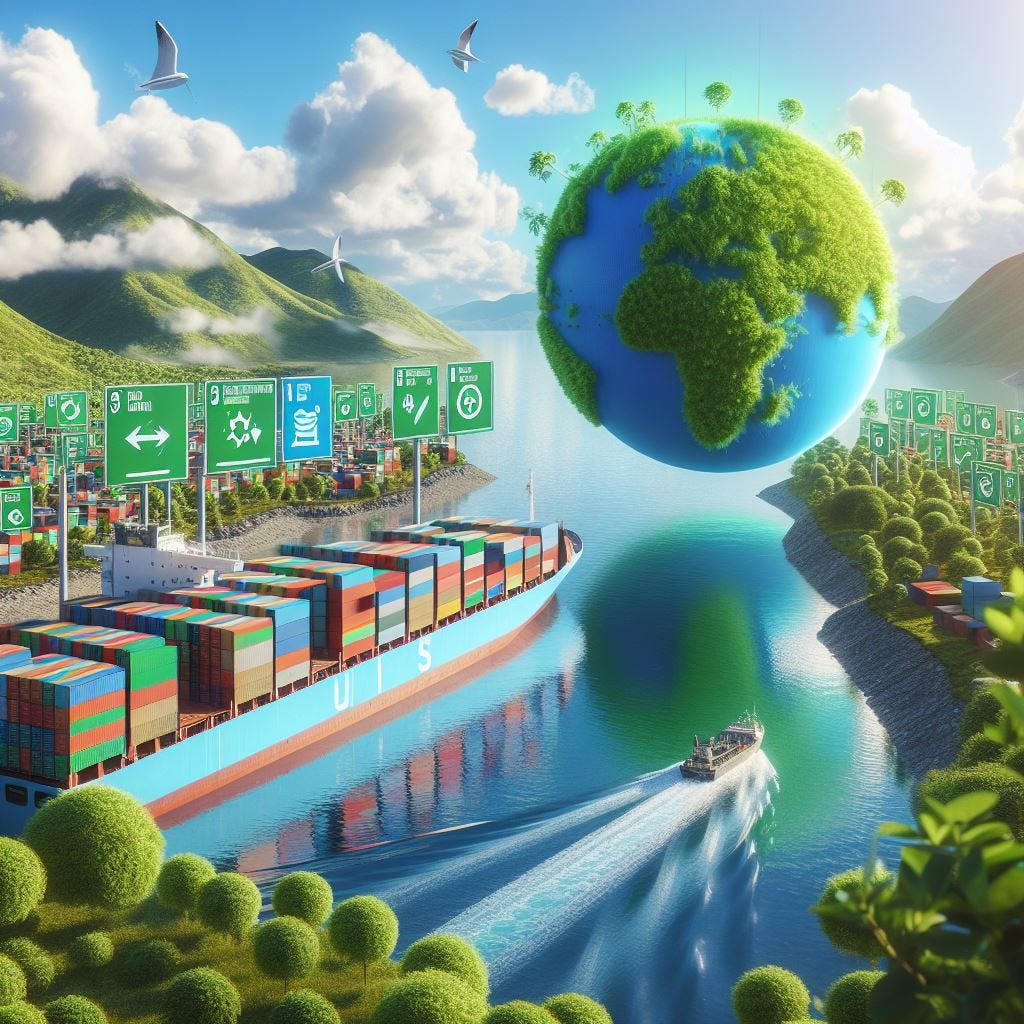🌎The Maritime Sustainability Edition - 01
Sailing Towards a 🌿 Greener Future in Container Shipping 🚢
Hello, Maritime Mavericks! 🚢🌊
Welcome Aboard - The Maritime Sustainability Edition! 🚢🌿
Embark on a journey with us as we dive into sustainable seas. In The Maritime Sustainability Edition, explore eco-tech, green shipping, and global initiatives shaping a cleaner future for container shipping.
Ready to sail with us? Let's make waves!
🚢 Navigating Knowledge: Container Shipping Quiz Time! 🚢
1- Maritime Industry Sets Sail on Green Fuel Horizon
Fuel Tech Surge: 50% of new maritime tonnage orders equipped for LNG, LPG, or methanol dual-fuel engines, up from one third last year.
Operational Shift: 6.52% of operational tonnage now running on alternative fuels, a notable increase from 5.5% in the previous year.
New Frontiers: Rise of methanol, LPG, and hydrogen, but ammonia-fueled ships remain absent in the official order book.
2- IMO's Aggressive Green Strategy: Quick Overview
IMO strengthens shipping goals, targeting 20-30% GHG reduction by 2030 and 70-80% by 2040.
Net-zero emissions "by or around" 2050 replaces the initial 50% reduction target.
2030 goal: 5-10% adoption of zero/near-zero GHG technologies in international shipping.
IMO plans measures: goal-based marine fuel standard and maritime GHG pricing, adopted in 2025, in force by mid-2027.
3- GHG Regulatory Timeline Snapshot: Toward 2030
IMO strengthens shipping goals for 20-30% GHG reduction by 2030, aiming for net-zero by 2050.
Measures, including a fuel standard and GHG pricing, expected by 2025 and enforced by mid-2027.
Implementing CII, SEEMP, and EEXI, while recognizing sustainable biofuels with 65% less emissions.
4- Future Expansion of MRV and ETS
Methane (CH4) and nitrous oxides (N2O) reporting begins in 2024, integrated into ETS from 2026.
Offshore ships report from 2027, with those over 5,000 GT included in ETS from the same year.
General cargo and offshore shipping (400-5,000 GT) added to MRV from 2025, under consideration for ETS in 2026.
Evaluation in 2026 for other cargo and passenger ships (400-5,000 GT) to join MRV and ETS.
5- Global Alternative Fuel Uptake: Snapshot
As of July 2023, a significant rise in alternative fuel adoption.
6.5% of operational ships and 51% on order can use alternative fuels, compared to last year's 5.5% and 33%, respectively.
In ship numbers, 1.8% are in operation, 26% on order, with 1,376 out of 5,258 ships ordered for alternative fuels.
Dominant uptake in battery/hybrid and LNG-fueled ships, with LNG fuel prevailing in gross tonnage, especially on smaller vessels.
The figures reveal a growing trend in methanol, LPG, and the first hydrogen-fueled newbuilds in the global fleet.
6- Driving Carbon-Neutral Fuel Demand in Shipping
Carbon-neutral fuel demand in shipping is fueled by GHG regulations, carbon pricing, and stakeholder expectations.
The level of demand hinges on global, regional, and national emissions regulations.
Shipping companies prioritize economically favorable GHG reduction measures, initially focusing on speed reduction and energy efficiency.
7- Fuel Price Modeling for Maritime Forecast
Utilizing the Marine Fuel Price Mapper model (DNV, 2022a), fuel-price scenarios were crafted for commercial Fuel-Selector projects.
Derived from scenarios in the 2022 edition of Maritime Forecast to 2050 (DNV, 2022a), five scenarios provide fuel prices for each year, showcasing a range of values (Figure 7-2).
8- Green Shipping Challenges: Closing the Cost Gap
Achieving green shipping corridors requires addressing the substantial fuel cost gap.
While EU ETS and IMO's market-based instruments aim to reduce costs, they may not achieve parity with conventional fuels by the decade's end.
If carbon prices prove insufficient, stakeholders may need to cover a green premium for carbon-neutral fuel, a cost most cargo owners may be unwilling to bear.
9- Shipping's Green Horizon: Decarbonization by 2050
Achieving shipping decarbonization by 2050 demands enhanced energy efficiency and logistics.
A significant shift in the fuel mix from traditional marine fuel oils is crucial.
New fuels from low-carbon sources, regardless of energy-efficiency gains, are pivotal for success.
A diverse future energy mix, gradually phasing out fossil fuels for sustainable alternatives.
The path to decarbonization necessitates a comprehensive transformation in both efficiency and fuel choices.
10- Narrowing Path to 1.5°C: Key Takeaways
Achieving a net-zero energy system by 2050 for a 1.5°C warming future is increasingly unlikely.
CO2 emissions are set to hit record levels in 2023, demanding a 19% reduction by 2030.
Technologies like solar PV and electric vehicles are on track, but others, including hydrogen production, lag behind.
Solar and wind capacity must increase fivefold, and storage capacity fourfold in the next decade.
Immediate, substantial cuts in fossil fuel use are essential to preserve hope for reaching the 1.5°C target.
* Source: DNV - Maritime Forecast to 2050. For more, please click the link to download the full report.
We read your emails, comments, and poll replies daily. Hit reply and let us know what you want more of! - Email: maritime-analytica@outlook.com
Have you missed any past newsletter? Check them out here:
For more daily news, follow up via Linkedin here:
For our exclusive market reports, online customized courses, advertisement services, and more, please complete the form:

